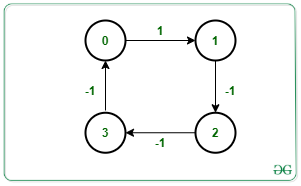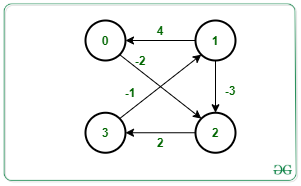给定一个由值为[0, N – 1]的节点、一个源S和一个类型为 { u, v, w } 的数组Edges[][3]组成的图G ,它表示节点u和v权重为w ,任务是检查给定源是否存在负循环。如果发现是真的,则打印“是” 。否则,打印“否” 。
A negative cycle is a cycle in which the sum of all its weight in that cycle is negative.
例子:
Input: N = 4, M = 4, Edges[][] = {{0, 1, 1}, {1, 2, -1}, {2, 3, -1}, {3, 0, -1}}, S = 0
Output: Yes
Explanation:

Starting from the source node 0, the graph contains cycle as 0 -> 1 -> 2 -> 3 -> 0.
The sum of weight in the above path is 1 – 1 – 1 – 1 = -2.
Therefore, the graph contains a negative cycle.
Input: N = 4, M = 5, Edges[][] = {{0, 2, -2}, {1, 0, 4}, {1, 2, -3}, {2, 3}, {3, 1}}, W[] = {-2, 4, -3, 2, -1}, S = 1
Output: Yes
Explanation:

Starting from the source node 1, the graph contains cycle as 1 -> 2 -> 3 -> 1.
The sum of weight in the above path is -3 + 2 – 1 = -2.
Therefore, the graph contains a negative cycle.
方法:这个想法是使用最短路径更快算法(SPFA)来查找负循环是否存在并且是否可以从图中的源顶点到达。请按照以下步骤解决问题:
- 用大值初始化数组dis[] ,用 false 和cnt[]初始化数组vis[ ]以存储有关顶点松弛次数的计数。
- 使用 SPFA 算法遍历图。
- 每当顶点放松时,增加每个顶点的计数。
The term relaxation means updating the cost of all vertices connected to a vertex v if those costs would be improved by including the path via vertex v.
- 停止算法并在某个顶点第N次放松后立即打印“是” ,因为只有N个顶点,即从0到N – 1 。
- 否则,打印“否” 。
下面是上述方法的实现:
C++
// C++ program for the above approach
#include
using namespace std;
bool sfpa(int V, int src, int Edges[][3],
int M)
{
// Stores the adjacency list of
// the given graph
vector > g[V];
// Create Adjacency List
for (int i = 0; i < M; i++) {
int u = Edges[i][0];
int v = Edges[i][1];
int w = Edges[i][2];
g[u].push_back({ v, w });
}
// Stores the distance of all
// reachable vertex from source
vector dist(V, INT_MAX);
// Check if vertex is present
// in queue or not
vector inQueue(V, false);
// Counts the relaxation for
// each vertex
vector cnt(V, 0);
// Distance from src to src is 0
dist[src] = 0;
// Create a queue
queue q;
// Push source in the queue
q.push(src);
// Mark source as visited
inQueue[src] = true;
while (!q.empty()) {
// Front vertex of Queue
int u = q.front();
q.pop();
inQueue[u] = false;
// Relaxing all edges of
// vertex from the Queue
for (pair x : g[u]) {
int v = x.first;
int cost = x.second;
// Update the dist[v] to
// minimum distance
if (dist[v] > dist[u] + cost) {
dist[v] = dist[u] + cost;
// If vertex v is in Queue
if (!inQueue[v]) {
q.push(v);
inQueue[v] = true;
cnt[v]++;
// Negative cycle
if (cnt[v] >= V)
return true;
}
}
}
}
// No cycle found
return false;
}
// Driver Code
int main()
{
// Number of vertices
int N = 4;
// Given source node src
int src = 0;
// Number of Edges
int M = 4;
// Given Edges with weight
int Edges[][3] = { { 0, 1, 1 },
{ 1, 2, -1 },
{ 2, 3, -1 },
{ 3, 0, -1 } };
// If cycle is present
if (sfpa(N, src, Edges, M) == true)
cout << "Yes" << endl;
else
cout << "No" << endl;
return 0;
} Java
// Java program for
// the above approach
import java.util.*;
class GFG{
static class pair
{
int first, second;
public pair(int first,
int second)
{
this.first = first;
this.second = second;
}
}
static boolean sfpa(int V, int src,
int Edges[][], int M)
{
// Stores the adjacency list of
// the given graph
Vector []g = new Vector[V];
for (int i = 0; i < V; i++)
{
g[i] = new Vector();
}
// Create Adjacency List
for (int i = 0; i < M; i++)
{
int u = Edges[i][0];
int v = Edges[i][1];
int w = Edges[i][2];
g[u].add(new pair(v, w));
}
// Stores the distance of all
// reachable vertex from source
int []dist = new int[V];
Arrays.fill(dist, Integer.MAX_VALUE);
// Check if vertex is present
// in queue or not
boolean []inQueue = new boolean[V];
// Counts the relaxation for
// each vertex
int []cnt = new int[V];
// Distance from src
// to src is 0
dist[src] = 0;
// Create a queue
Queue q = new LinkedList<>();
// Push source in the queue
q.add(src);
// Mark source as visited
inQueue[src] = true;
while (!q.isEmpty())
{
// Front vertex of Queue
int u = q.peek();
q.remove();
inQueue[u] = false;
// Relaxing all edges of
// vertex from the Queue
for (pair x : g[u])
{
int v = x.first;
int cost = x.second;
// Update the dist[v] to
// minimum distance
if (dist[v] > dist[u] + cost)
{
dist[v] = dist[u] + cost;
// If vertex v is in Queue
if (!inQueue[v])
{
q.add(v);
inQueue[v] = true;
cnt[v]++;
// Negative cycle
if (cnt[v] >= V)
return true;
}
}
}
}
// No cycle found
return false;
}
// Driver Code
public static void main(String[] args)
{
// Number of vertices
int N = 4;
// Given source node src
int src = 0;
// Number of Edges
int M = 4;
// Given Edges with weight
int Edges[][] = {{0, 1, 1},
{1, 2, -1},
{2, 3, -1},
{3, 0, -1}};
// If cycle is present
if (sfpa(N, src, Edges, M) == true)
System.out.print("Yes" + "\n");
else
System.out.print("No" + "\n");
}
}
// This code is contributed by 29AjayKumar Python3
# Python3 program for the above approach
import sys
def sfpa(V, src, Edges, M):
# Stores the adjacency list of
# the given graph
g = [[] for i in range(V)]
# Create Adjacency List
for i in range(M):
u = Edges[i][0]
v = Edges[i][1]
w = Edges[i][2]
g[u].append([v, w])
# Stores the distance of all
# reachable vertex from source
dist = [sys.maxsize for i in range(V)]
# Check if vertex is present
# in queue or not
inQueue = [False for i in range(V)]
# Counts the relaxation for
# each vertex
cnt = [0 for i in range(V)]
# Distance from src to src is 0
dist[src] = 0
# Create a queue
q = []
# Push source in the queue
q.append(src)
# Mark source as visited
inQueue[src] = True
while (len(q)):
# Front vertex of Queue
u = q[0]
q.remove(q[0])
inQueue[u] = False
# Relaxing all edges of
# vertex from the Queue
for x in g[u]:
v = x[0]
cost = x[1]
# Update the dist[v] to
# minimum distance
if (dist[v] > dist[u] + cost):
dist[v] = dist[u] + cost
# If vertex v is in Queue
if (inQueue[v] == False):
q.append(v)
inQueue[v] = True
cnt[v] += 1
# Negative cycle
if (cnt[v] >= V):
return True
# No cycle found
return False
# Driver Code
if __name__ == '__main__':
# Number of vertices
N = 4
# Given source node src
src = 0
# Number of Edges
M = 4
# Given Edges with weight
Edges = [ [ 0, 1, 1 ],
[ 1, 2, -1 ],
[ 2, 3, -1 ],
[ 3, 0, -1 ] ]
# If cycle is present
if (sfpa(N, src, Edges, M) == True):
print("Yes")
else:
print("No")
# This code is contributed by SURENDRA_GANGWARC#
// C# program for
// the above approach
using System;
using System.Collections.Generic;
class GFG{
class pair
{
public int first, second;
public pair(int first,
int second)
{
this.first = first;
this.second = second;
}
}
static bool sfpa(int V, int src,
int [,]Edges, int M)
{
// Stores the adjacency list of
// the given graph
List []g = new List[V];
for (int i = 0; i < V; i++)
{
g[i] = new List();
}
// Create Adjacency List
for (int i = 0; i < M; i++)
{
int u = Edges[i, 0];
int v = Edges[i, 1];
int w = Edges[i, 2];
g[u].Add(new pair(v, w));
}
// Stores the distance of all
// reachable vertex from source
int []dist = new int[V];
for (int i = 0; i < V; i++)
dist[i] = int.MaxValue;
// Check if vertex is present
// in queue or not
bool []inQueue = new bool[V];
// Counts the relaxation for
// each vertex
int []cnt = new int[V];
// Distance from src
// to src is 0
dist[src] = 0;
// Create a queue
Queue q = new Queue();
// Push source in the queue
q.Enqueue(src);
// Mark source as visited
inQueue[src] = true;
while (q.Count != 0)
{
// Front vertex of Queue
int u = q.Peek();
q.Dequeue();
inQueue[u] = false;
// Relaxing all edges of
// vertex from the Queue
foreach (pair x in g[u])
{
int v = x.first;
int cost = x.second;
// Update the dist[v] to
// minimum distance
if (dist[v] > dist[u] + cost)
{
dist[v] = dist[u] + cost;
// If vertex v is in Queue
if (!inQueue[v])
{
q.Enqueue(v);
inQueue[v] = true;
cnt[v]++;
// Negative cycle
if (cnt[v] >= V)
return true;
}
}
}
}
// No cycle found
return false;
}
// Driver Code
public static void Main(String[] args)
{
// Number of vertices
int N = 4;
// Given source node src
int src = 0;
// Number of Edges
int M = 4;
// Given Edges with weight
int [,]Edges = {{0, 1, 1},
{1, 2, -1},
{2, 3, -1},
{3, 0, -1}};
// If cycle is present
if (sfpa(N, src, Edges, M) == true)
Console.Write("Yes" + "\n");
else
Console.Write("No" + "\n");
}
}
// This code is contributed by 29AjayKumar Javascript
Yes时间复杂度: O(N*M),其中 N 是顶点数,M 是边数。
辅助空间: O(N + M)
如果您希望与专家一起参加现场课程,请参阅DSA 现场工作专业课程和学生竞争性编程现场课程。